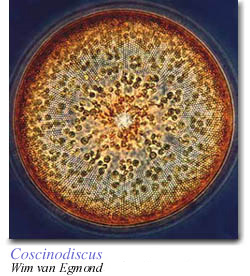![]()
![]() hat
are the internal parts of a diatom?
hat
are the internal parts of a diatom?
The soft organic part of the diatom is made
up of protoplasm, the gelatinous substance that makes up most living cells.
The protoplasm includes the cell's nucleus, chloroplasts, and oil globules,
among other things. The
following illustration is a cutaway view of a diatom showing its internal
composition.
The internal parts of the diatom cell are similar to many other types of cells so we won't go into much detail here, except for discussion of chloroplasts. Chloroplasts are the most noticeable internal component of almost all diatoms, giving the diatom its color and photosynthetic capabilities. The photomicrograph of Coscinodiscus shown below exhibits numerous yellowish-brown chloroplasts in an otherwise clear organism. The number and shape of chloroplasts varies greatly between different species of diatoms and Coscinodiscus contains many more smaller chloroplasts than shown in our schematic diagram above. Keep in mind that the cutaway diagram of a diatom is a very generalized schematic and cannot adequately describe the variation in all diatoms.

As the image of Coscinodiscus shows, diatom chloroplasts are usually yellowish-brown in color, ranging between yellowish-green and dark brown. This coloration is due to the presence of photosynthetic pigments such as chlorophyll, beta carotene, and fucoxanthin. The pigment chlorophyll is also a key component of terrestrial plants. Without this pigment, neither plants nor diatoms grow very well. While houseplant collectors admire variegation, the alternating white and green areas of leaves, too much white relative to green weakens the plant by reducing pigments that capture sunlight. Very few non-pigmented diatoms exist in nature and these exceptions do not rely on photosynthesis to grow.
